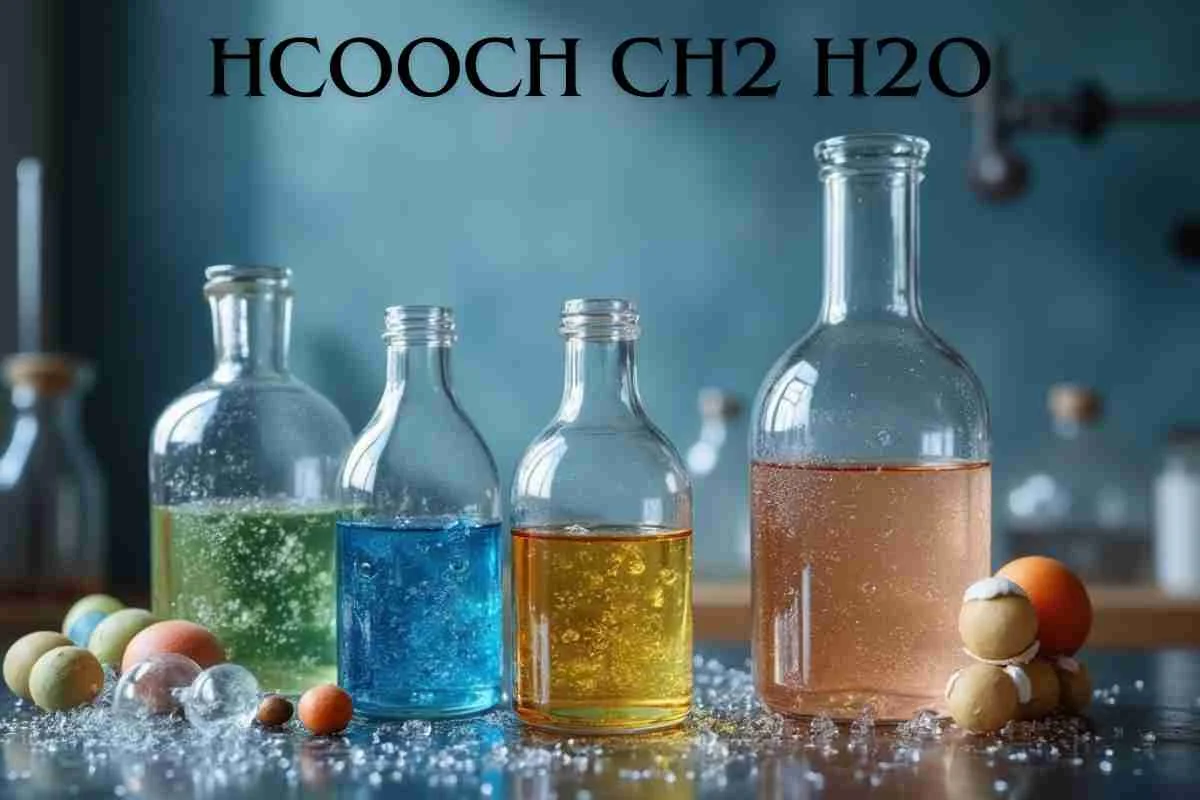In the vast tapestry of chemical notation, few strings look as puzzling at first glance as hcooch ch2 h2o. At first reading it seems almost like a typo, an artefact of a mis‑formatted lab notebook. Yet, when we slow down and examine each fragment—HCOOH (formic acid), CH₂ (a methylene bridge), and H₂O (water)—a rich story of interactions, history, and modern‑day applications emerges. This article unpacks that story in plain language, weaving practical examples with a dash of wonder, and, of course, placing hcooch ch2 h2o center stage throughout.
A String, Three Components, Countless Possibilities
Let’s break down hcooch ch2 h2o into its constituent parts. HCOOH is the simplest carboxylic acid, known as formic acid, famous for giving ant bites their sting. CH₂ is the basic methylene unit that forms the backbone of countless organic molecules, from plastics to natural products. H₂O, water, needs no introduction: it is the universal solvent and the medium of life. When chemists see the compact cluster hcooch ch2 h2o, they envision how a proton‑donating acid might interact with carbon‑rich fragments in an aqueous environment to produce reactions that are both subtle and profound.

Nature’s Own Micro‑Laboratory
In living cells, formic acid appears not only in ants but also in certain metabolic pathways where one‑carbon units are shuffled about. The union suggested by hcooch ch2 h2o mirrors how a cell might temporarily “park” a formyl (HCOO‑) group on a methylene carrier before water facilitates the next enzymatic step. This molecular hand‑off underpins processes as critical as DNA synthesis and energy production. In other words, hcooch ch2 h2o is not merely text; it’s a snapshot of life’s nanoscopic logistics network.
Industrial Echoes of Biological Design
Industry often imitates biology, scaling up what evolution perfected. Consider the manufacture of formaldehyde resins or certain pharmaceuticals where a formyl group must be introduced with surgical precision. Engineers set up reactors that, in effect, recreate the environment implied by hcooch ch2 h2o: formic acid dripped into a solution of methylene‑rich compounds while water moderates temperature and dilutes by‑products. The result might be an adhesive that bonds plywood, or an intermediate for a life‑saving drug. Thus, hcooch ch2 h2o sits quietly at the foundation of products lining supermarket shelves.
The Acid–Base Ballet
Formic acid is a classic Brønsted acid, while water can act as both acid and base. When the two meet, proton transfer kicks off instantly: HCOOH + H₂O ⇌ HCOO⁻ + H₃O⁺. Slip a reactive CH₂ fragment into the scene—as hinted by hcooch ch2 h2o—and you open the door to nucleophilic additions, substitutions, or even polymerization. Students often perform a simple demonstration: mixing diluted formic acid with paraformaldehyde in water yields a faint odor of formaldehyde, proof that the network behind hcooch ch2 h2o is practically tangible.
Green Chemistry’s Hidden Hero
Sustainability circles praise formic acid as a potential hydrogen carrier: under mild conditions it decomposes to CO₂ and H₂, releasing clean fuel. Researchers are exploring catalysts that tether a CH₂‑bearing ligand to a metal center, effectively encoding hcooch ch2 h2o into the design. Water’s presence keeps the system benign and recyclable. If commercialised, buses or data centers might one day tap a supply chain rooted, at least conceptually, in hcooch ch2 h2o.
A Historical Detour
The first isolation of formic acid (HCOOH) in 1671 came from distilling crushed ants. It took another two centuries before chemists could visualise carbon skeletons, let alone write shorthand like hcooch ch2 h2o. When August Kekulé sketched the methylene unit (CH₂) in the mid‑1800s, and when water’s role in acid dissociation became textbook knowledge, the pieces finally existed to interpret such a formula. Therefore, hcooch ch2 h2o is a 21st‑century contraction of ideas developed painstakingly over hundreds of years.
Laboratory Tips for the Modern Chemist
Suppose you want to replicate a reaction scheme inspired by hcooch ch2 h2o in your own lab. A few pointers:
- Purity matters. Technical‑grade formic acid often contains traces of metals that can derail sensitive catalysis.
- Control water content. Too much H₂O dilutes reactants; too little hampers proton mobility.
- Temperature is key. Many formylation reactions run best around 40 – 60 °C, striking a balance between speed and unwanted side‑reactions.
Write hcooch ch2 h2o on your fume‑hood sash as a mnemonic: acid, carbon core, solvent—optimize all three, and yields soar.
Everyday Encounters You Might Miss
Even beyond laboratories, you brush against the legacy of hcooch ch2 h2o daily. That no‑smell, no‑residue household cleaner advertised as “plant‑based” often contains formic‑acid‑derived salts. Some synthetic leather uses methylene‑bridged polymers whose precursor route features our trio. Café owners deploying modern “low‑carbon” coffee roasters sometimes inject formic acid–water mist to tweak bean chemistry, echoing the microdosing logic embedded in hcooch ch2 h2o.
Teaching Moments for Curious Minds
Educators can leverage hcooch ch2 h2o as a pedagogical prism:
- Stoichiometry drills: Ask students to balance hypothetical reactions joining HCOOH, CH₂ fragments, and H₂O.
- Acid–base titrations: Use dilute formic acid versus sodium hydroxide to visualize equivalence points.
- Spectroscopy labs: Challenge learners to predict IR peaks for carbonyl stretches and O‑H bends within the ensemble.
When a chalkboard spells out hcooch ch2 h2o, teenagers suddenly realize formulas are stories waiting to be read.
Future Horizons
Cutting‑edge work in CO₂ reduction cycles back to formic acid as a transient storage molecule. Synthetic biologists are engineering microbes that convert waste CO₂ into poly‑hydroxybutyrate through pathways that momentarily resemble hcooch ch2 h2o. Meanwhile, materials scientists are building self‑healing polymers where a latent methylene linker reacts with ambient moisture and traces of formic acid to seal micro‑cracks, a living embodiment of the reactivity implied by hcooch ch2 h2o.
The Poetry of Symbols
Chemistry, some say, is the closest science to poetry because it translates the real into the symbolic and back again. The phrase hcooch ch2 h2o illustrates this beautifully. Strip away the capitalization, punctuation, and it still whispers clues about acidity, bonding, and the omnipresence of water. Read aloud, it has rhythm: “H‑cooch, C‑H‑two, H‑two‑O.” Beneath that rhythm lies a set of interlocking principles that shape batteries, medicines, and even the aroma of rainforest soil after rain.
Closing Reflections
The next time you encounter a cryptic cluster of letters and numbers in a recipe, textbook, or research paper, pause and imagine the hidden drama. In just eleven characters, hcooch ch2 h2o compresses the tales of ant venom, industrial adhesives, cellular metabolism, and a hopeful green‑energy future. It reminds us that behind every symbol lies a universe of interactions—and that understanding them can empower innovations large and small.
In short, hcooch ch2 h2o is more than a quirky keyword; it’s a gateway. Peer through it, and you step into a world where acids converse with carbons in the language of water, where centuries of scientific curiosity converge, and where tomorrow’s breakthroughs may already be taking shape in a beaker, a battery, or perhaps even in the tiny mandibles of an unassuming ant.








Leave a Reply